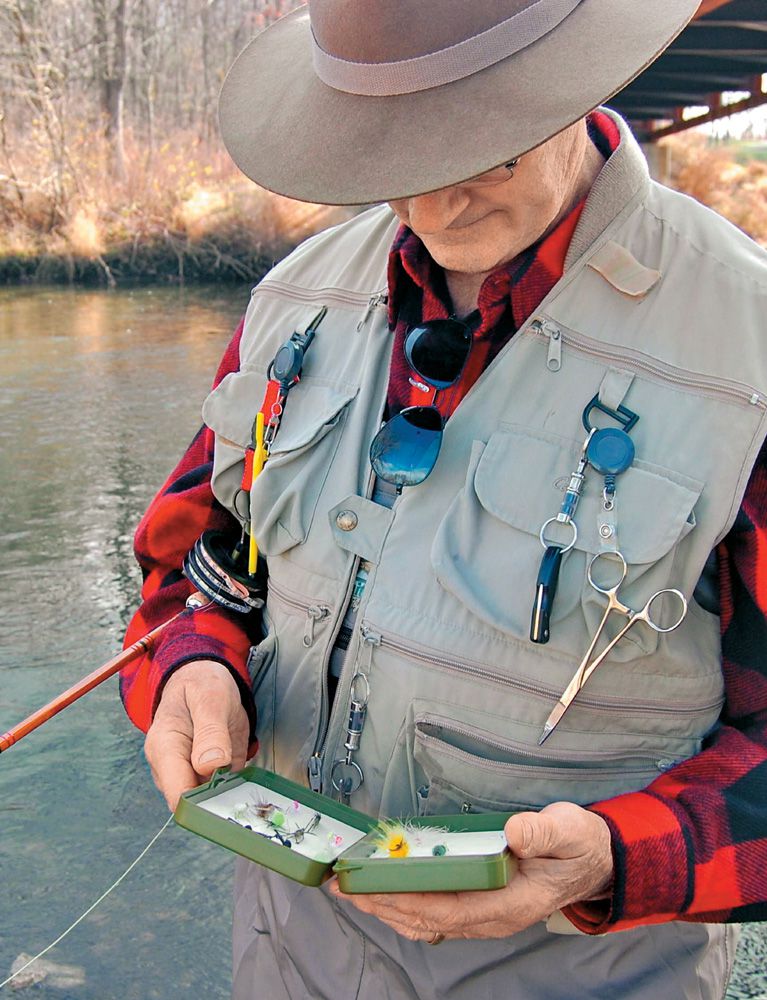


Wading staffs are great when you need them and a nuisance when you don’t. You need them when you get too deep into a stream, get into fast water, or are carrying a camera. Other times, they can get in the way and even trip you.
The easy solution is to carry a folding wading staff in a holster on your wader belt. Several are available on the market, varying in lengths suit any angler. All have an internal bungee cord, so when you pull the staff out of the holster by the handle, the rest of the wading staff springs and locks into a sturdy staff. The sections will not stay joined if the tip of the staff gets stuck in the mud, but that is a minor inconvenience.
An inexpensive but still effective approach is to buy used ski poles, frequently found at flea markets and garage sales. You can use the poles in one of two ways, depending on the terrain. For wading on sandy or mucky bottoms, you can keep the ski pole as is, with the webbing (usually plastic) near the base serving as a “snowshoe” to prevent the pole from sinking too deep into the bottom. Alternatively, you can remove the plastic webbing (with wire cutters or a hacksaw) to make a straight pole for rocky streams. Add a lanyard that you can attach to your bootstrap or fishing vest to prevent loss of the recycled wading staff.
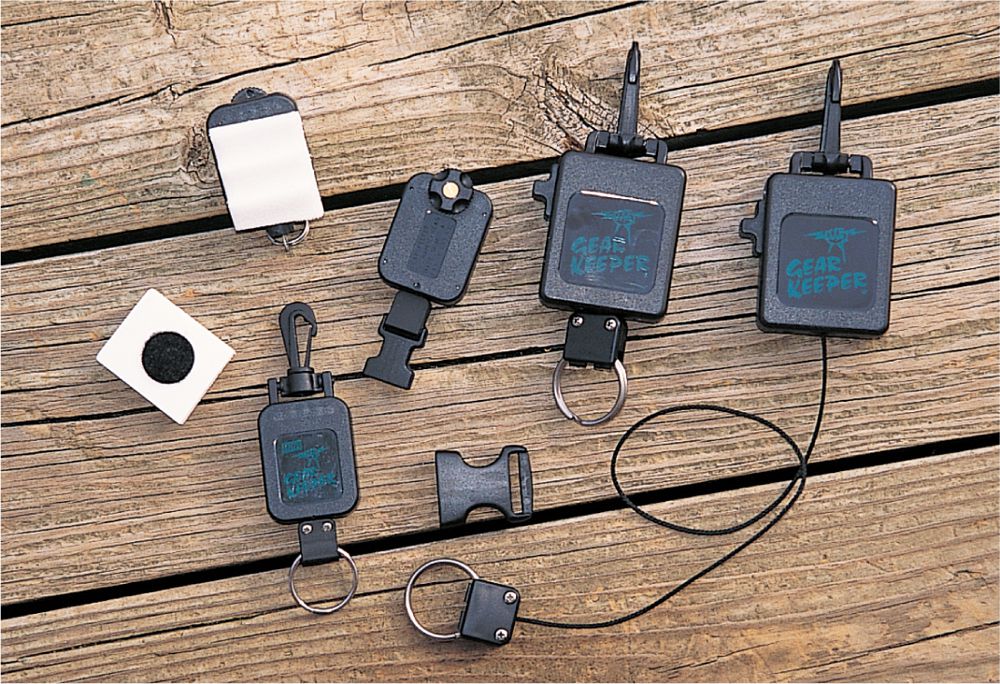

To avoid losing gear, use lanyards or retractable pull cords that are stored in small reels. Often these are generically called “zingers.” Lanyards are good for fishing pliers, wading staffs, clippers, nippers, dry fly dressing bottles, nets, and similar gear. Small ones for nippers and clippers are available from all fly shops. Larger, heavy-duty models are necessary for holding pliers, landing nets, wading staffs, etc. The best of these currently available are the Hammerhead Gear Keepers, which come in many styles, different attachment methods, and also different strengths and pull tensions.

You can make a simple lanyard for pliers by using a plastic coil-spring key chain, usually available for a few bucks at most discount stores. To do this, use the split ring end to attach to the pliers, and attach a clip or snap on the other end to your fishing vest or wader belt. You can use these, which stretch several feet, without risking loss. They also work with nets and other gear.
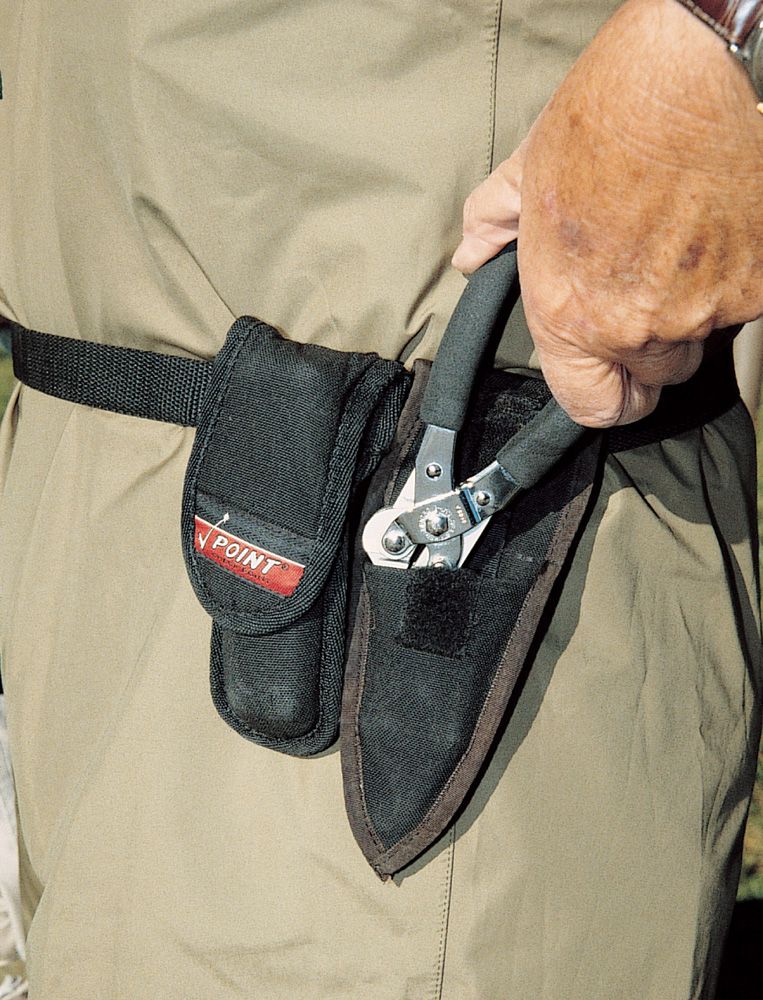

Most anglers carry sheathed fishing pliers at all times. The easy way to carry pliers is on your wader safety belt. If fishing in saltwater, nylon sheaths are better than leather sheaths. Wash out nylon sheaths as required. Leather sheaths soak up and hold salt, which can be detrimental to any equipment.
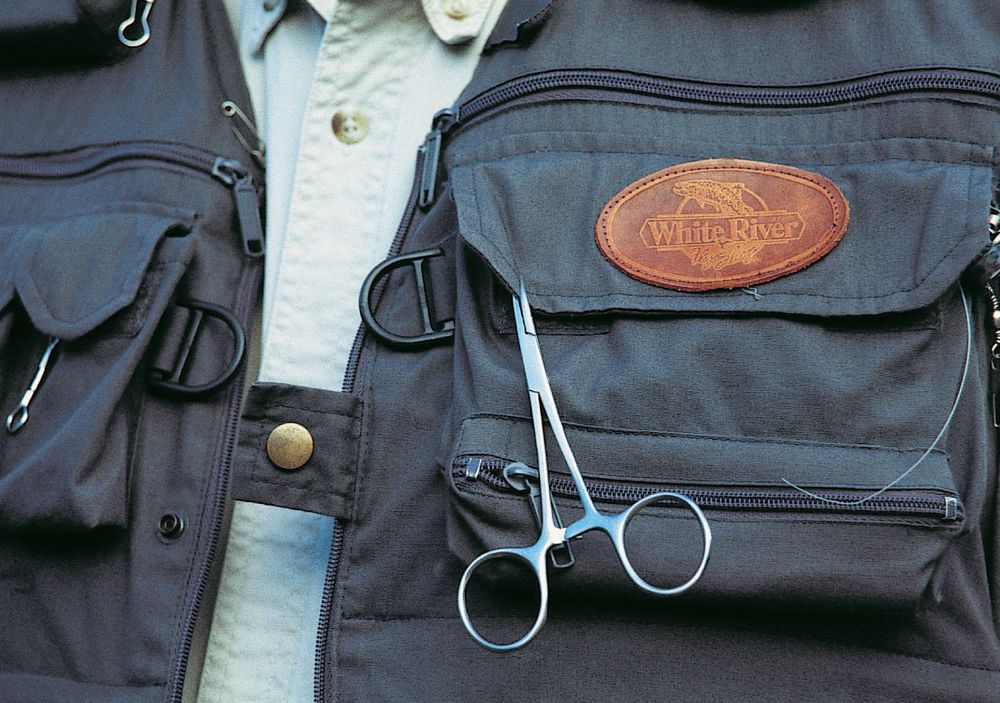

Surgeons use hemostats, or clamping forceps; fly anglers do, too. They are handy for holding small flies when tying knots and especially to remove flies from landed fish. Forceps allow careful clamping and holding of a fly hook so that you can remove the fly from the fish’s jaw with minimal damage and handling of the fish. As such, they are ideal for catch-and-release fishing.
To keep them with you, clamp the jaws onto a pocket flap of your fishing vest, pack, or shirtfront.
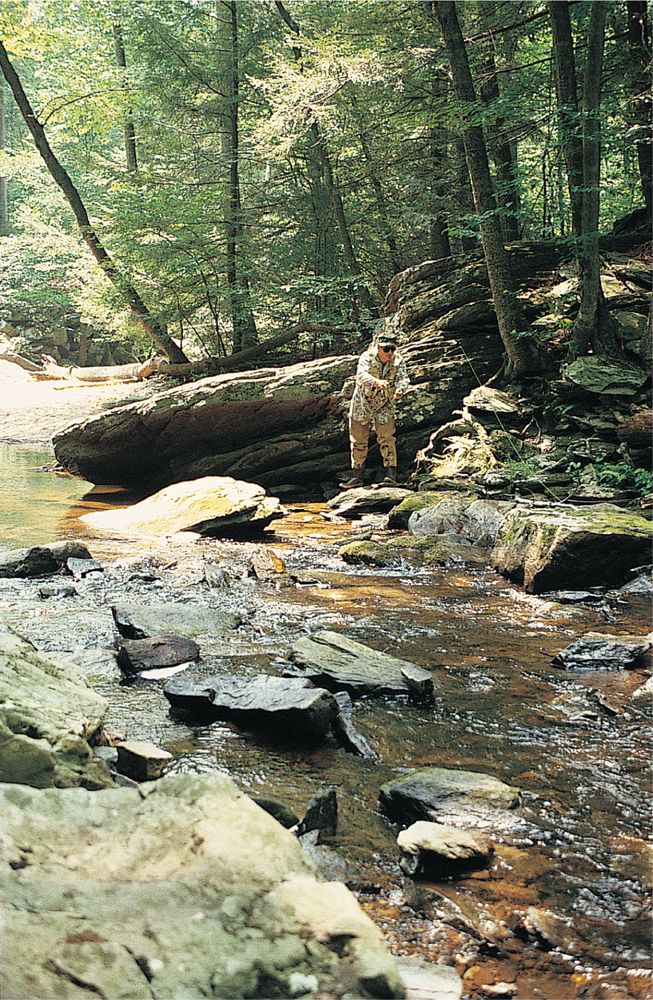

Most fishing vests are tan, gray, or green. You will seldom find large blocks of one solid color in nature, and such vests might spook trout in shallow-water streams. To camouflage yourself while fishing, wear a camouflage shirt or lightweight jacket, similar to what hunters wear. But for best results, wear the jacket over your fishing vest to disguise and hide that solid color. You can leave the jacket open in front to easily get flies and other necessities from your pockets, while the mixed pattern of the jacket or shirt hides you from the trout.
Choose the pattern of camouflage to match the woods where you will be fishing. Available camouflages include spring woods, fall trees, large trees, winter with snow, barren areas, and others. A spring (green pattern) woods look is best for most early season trout fishing.

Stick a few different-size safety pins into your fishing vest. They are handy for clearing the head cement out of flies. Different sizes make this task easy on various-size flies. They are also handy if something breaks on a strap or other part of your gear, to be used for a quick, temporary repair.
If you wear chest-high waders and often fish deep, get a “shorty” fishing vest to prevent the vest from getting wet. If you are fishing in hip boots, a full-length vest gives you more room and pockets. An alternative to the shorty vest for deep-wading fly anglers is to wear a long vest, but wear it inside your waders if there is enough room.
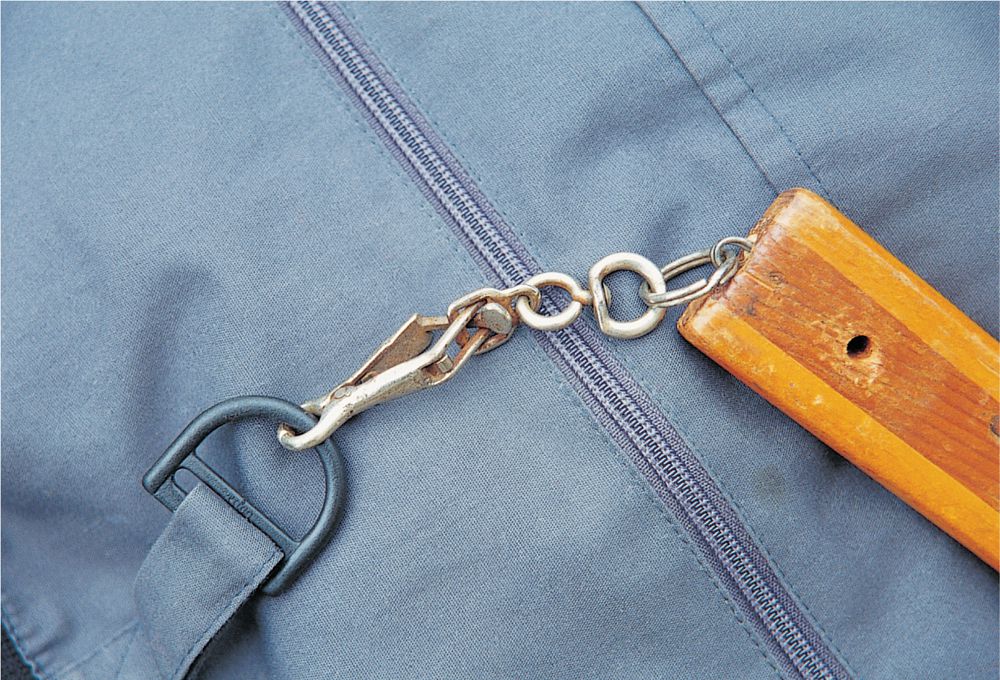

Attach a landing net to the D-ring located on the back of all fishing vests. This is the best way to carry a landing net while stream fishing. (If your vest does not have a D-ring, you can add a key-style split ring to the strap or use a short cloth strap to sew a D-ring in place.) Buy a French snap from a hardware store and attach it to the end of the landing net. These snaps are unlike dog leash snaps in that you operate them by squeezing the two arms or sides to open the snap in the middle. This makes it easy to remove the net hung from your back by reaching around to unsnap it. Carrying the net on the back center of your vest also reduces the possibility of the net catching on tree limbs and brush.
Chest packs are a substitute for fishing vests. They have the advantage of holding the accessories higher on the chest and back. They hold less equipment, but are ideal when you want to wade deep or fish with only a few items, such as in saltwater and tropical fishing. Many sizes and styles are available, some simple fore and aft bags, and others are complex with special tool pockets and other features.
Lightweight travel waders are best for all fishing. The alternative if you fish a lot of different places is to have two pairs of waders—one heavy neoprene for cold weather and a second lightweight pair for warm-weather fishing. Lightweight travel waders are fine for fishing in warm weather, and in cold weather you can insulate them by donning flannel pajama bottoms or insulated wear under your regular fishing pants.


Many waders today include a belt that fits around your waist outside of the waders. This is for safety, because if you fall in, the belt limits the amount of water that seeps into your waders. If your waders do not have this, buy a nylon belt or make one from nylon strapping and some snaps or Swedish buckles that allow for instant on/off of the belt. Buy 3 feet (0.9 m) or more (check your waist size with the waders on) of 1-inch (2.5-cm) nylon strapping and mating plastic snaps. Sew one end of the strapping to one snap and thread the other end through the two openings on the other snap. Tighten the belt around your waist anytime you wear waders.
When buying new waders, hip boots, or other wading or heavy boots, do so at the end of the day. That is when your feet swell, making an accurate measurement easier. Also, wear the socks that you would normally wear for fishing. Some anglers wear two pairs of regular socks, some a single pair of very heavy wool socks, and some a pair of medium wool socks over lightweight cotton socks.
This is important, even if buying boots online or by mail order. In that case, put on the appropriate socks at the end of the day, stand on paper on a hard floor, and have someone else trace around your foot. Send this tracing to the mail-order company or use its instructions to convert this information to the correct size. Often the best fit is a half or full size larger in a boot than you wear in a dress shoe.
Boot-foot waders are easier to put on and take off and are easier to travel with than separate wading shoes and stocking-foot waders. But for the best ankle support, the high top, heavy-leather wading shoes teamed with stocking-foot waders are best. If you have weak ankles, have broken or badly strained/sprained an ankle, or are fishing over a very rough bottom, strongly consider these separate wader and wading shoe combinations.

Chain or stud types of slip-on rubber grippers are available to fit over waders or hip boots. These are elastic to fit the boot bottom, but with metal studs or cleats to grip the algae-covered rocks. You can use them for both boot-foot and separate wading-boot waders. These are highly recommended for really slippery bottoms, since the studs or chains cut through the scum and algae on rocks and gravel.
Master fly rod guru Lefty Kreh related a tip long ago about the problems of fishing with hip boots. As manufactured, the adjustable buckle on the outside of the hip boot strap often catches fly lines and ruins the cast. To avoid this, remove the adjustable strap from the buckle, reverse the direction of the strap going through the buckle so that the strap and buckle are on the inside (next to your pant leg) and not able to catch the fly line. It will be a little harder to change the strap adjustment, but does cause fewer tangles when casting.
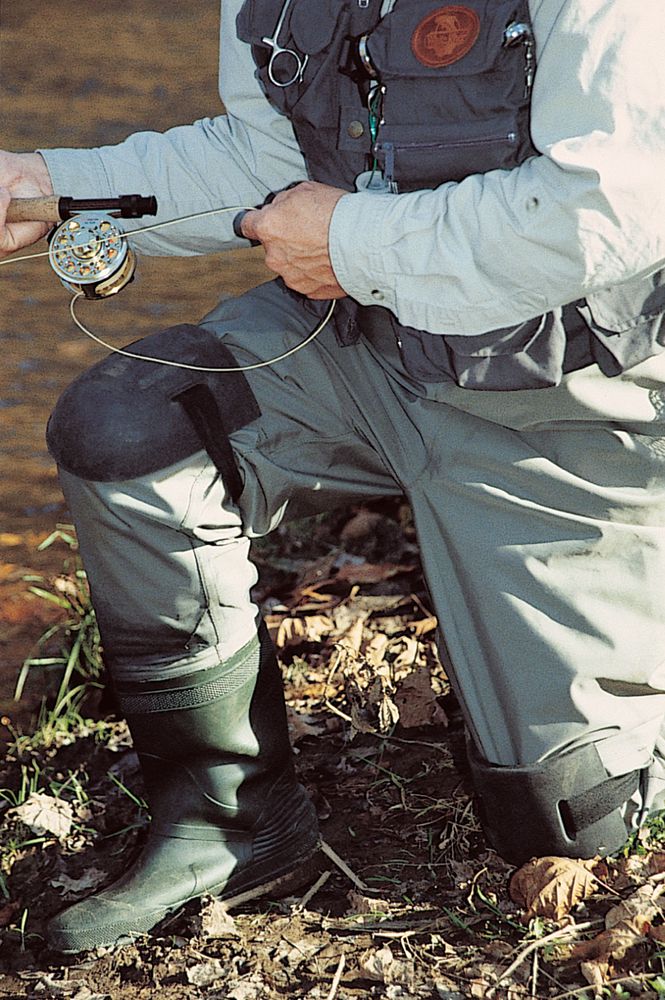

The best trout fishermen on small streams wear out the knees of their waders before they wear out the soles. Anglers kneel to prevent the small stream trout from seeing them, and are thus able to present the fly more carefully and precisely. If you do a lot of this type of fishing, there are ways to prevent wader knee wear. Get comfortable knee pads from a home supply or hardware store. The most comfortable kind fit on with hook-and-loop fastener straps. Keep them in your fishing vest or with your gear to wear when needed.

If you do a lot of wading and are over the age of 25, consider wearing a back brace while wade fishing, suggests expert Chuck Edghill. These large braces fit tightly around the back and waist. Hook-and-loop fasteners (or suspenders) keep the braces in place. Wear the brace over your shirt, but under your fishing vest. You can loosen the brace when taking a break. The suspenders may help reduce muscle strain when wading for long periods of time and allow you to fish comfortably longer.
As we get older, many of us have trouble tying small flies to thin tippets, particularly with non-prescription sunglasses or when fishing at dawn or dusk. To solve this, buy some of the clip-on close-up lenses. Gudebrod, for example, makes Fold Away Reading Glasses in eight magnifications from +1.50 to +3.25 for any vision needed. They clip onto any visor or billed cap for easy use in the field, and flip out of the way when not needed.
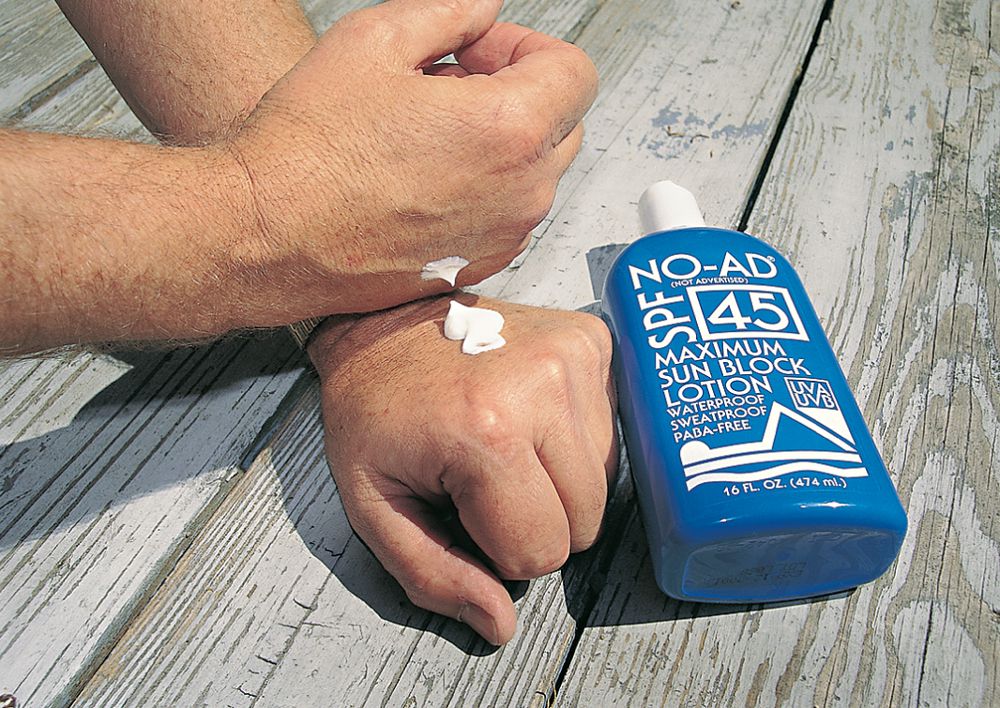

Fish can smell sunscreen and insect repellent, so you must keep it off your fishing gear. However, you frequently have to apply and reapply lotions during the day to protect your skin from sunburn and bites. To do this without getting it on your tackle or flies, spread the lotion on the back of one hand and then spread it over your opposite arm, face, ears, back of the neck, front of the neck, and anywhere else needed.
Spread some on the back of your other hand to repeat on spots that you cannot reach with your first hand. The result is total protection without ever getting the lotion on the palms of your hands with which you handle tackle and flies.

If you are out in the hot sun for long periods, are tropical fishing, or have very sensitive light skin, consider “Lawrence of Arabia” headgear for your fly fishing. Several companies make caps or hats with an attached, roll-out neck protector, just as you see in films of Lawrence of Arabia and the French Foreign Legion. While sunscreen is essential, these neck shields provide extra protection for the back of the neck and ears during a long day outdoors.
If you don’t want to buy this specialized head gear, you can accomplish the same thing with a standard fishing cap and handkerchief. Use several small safety pins to attach one edge of the handkerchief to the back rim of the cap. For emergency use when you don’t have pins, place the handkerchief on the back of your head and carefully place the cap over it to hold it in place. Just don’t take your cap off while fishing—you might lose your handkerchief.
In the hot sun, one way to keep cool is to wet your hat so that the evaporation cools your head as you fish. Some cap brims are made of stiff cardboard, so wet only the cloth head-covering part. If you are fishing in saltwater, use water from the cooler, since caps dipped in saltwater get sticky, stiff, and uncomfortable. Another way to keep cool is to slip an ice cube or two under your cap.


Windy situations can cause you to lose a hat or cap in a hurry, and sometimes it will sink before you can get it or can turn the boat around to retrieve it. To prevent this, use a lanyard clip that fastens the back of your hat to the back of your fishing shirt or jacket. If you do not have one or cannot find one, get two spring clips (banker’s clips or bulldog clips, available at office supply stores) and tie them to the ends of a shoelace or foot-long (30-cm) cord. Then, when the wind increases, pull the clip out of your fishing vest pocket, and clip to your hat and shirt to prevent loss.
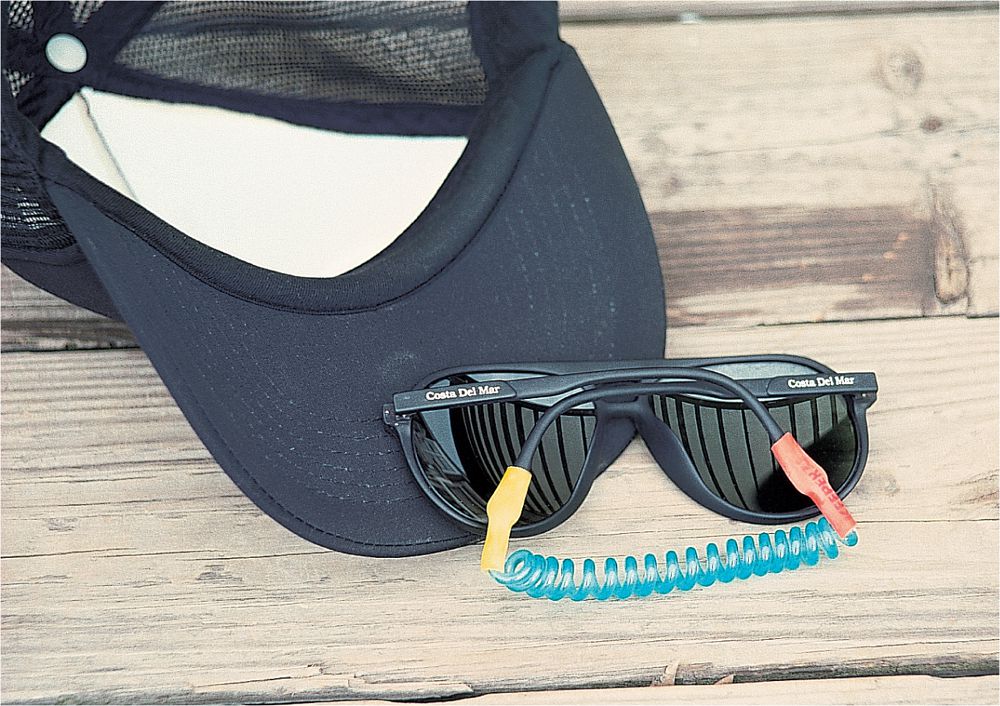

A hat or cap with a light underbrim bounces sunlight reflected from the water surface back into your eyes. A dark brim absorbs the light, which prevents eyestrain. If necessary, you can coat a favorite hat underbrim with black shoe polish or permanent black felt-tip marker.

Gloves of wool or heavy yarn synthetics provide best warmth when cold-weather fly fishing. The best of these have exposed fingers (fingerless gloves) so that you can handle flies, tie knots, prepare leaders, etc., while fishing without removing your gloves. Alternatives are mittens that have a covered palm opening to allow extending your fingers for tying knots and working with flies.

With more and more concern about skin cancer from the sun, anglers should consider wearing sun gloves while fishing. These thin gloves with exposed fingertips (for tying knots and handling flies) protect the backs of your hands from the damaging UV rays of the sun.
Polarizing sunglasses allow you to see through the surface and minimize eye glare to make fishing easier and more pleasant. By allowing you to see underwater, they allow you to spot fish and structure and detect currents.
If possible, bring different types of polarizing sunglasses for different fishing and lighting situations. Glasses with gray, copper, or brown lenses provide maximum sun protection and minimum light transmission and are best for bright sun or when fishing sandy flats. They have a light transmission of about 12 to 17 percent.
For dim light situations, use yellow or orange glasses, which provide good contrast and are best for spotting fish. These have a transmission of about 25 to 32 percent.
Blue-gray is often best for offshore and open-water fishing.
The effectiveness of polarizing glasses is dependent upon the angle at which the sun or sun reflection off the water hits your glasses. Sometimes you can improve this by tilting your head slightly to one side or the other to change the sun angle.
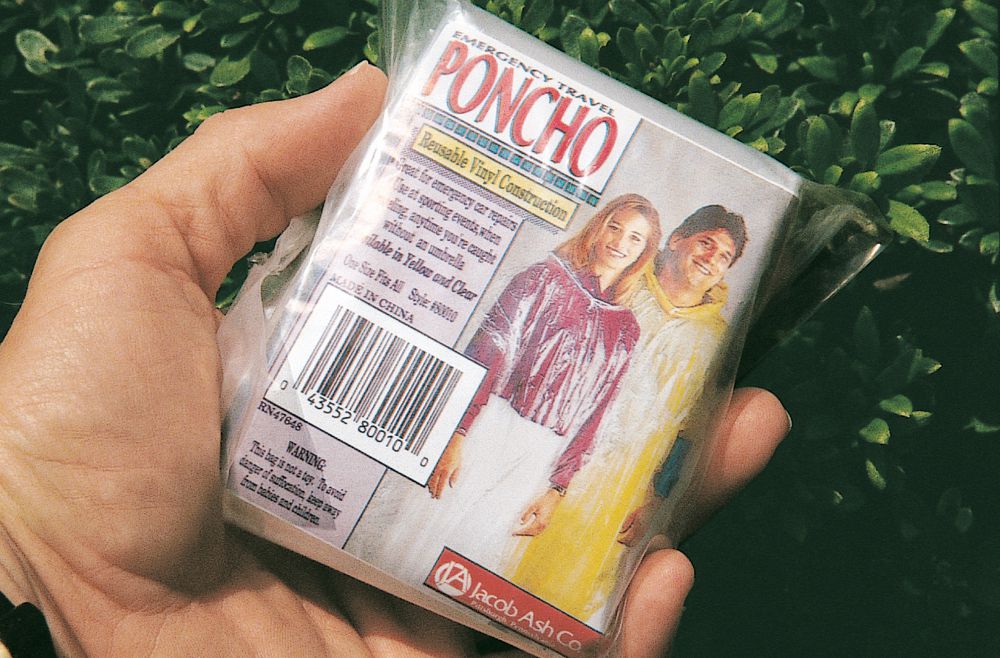

It can rain at any time, so always carry a raincoat while fishing. When wading, you have to carry it in the large pocket in the back of your fishing vest or chest pack where it can be heavy, bulky, and hot. A simpler method is to carry one of the disposable clear plastic rain parkas that covers completely when wearing chest-high waders and is long enough when wearing hip boots.
Disposable raincoats are inexpensive and available from fly shops, tackle shops, general sporting goods stores, camping supply stores, and many discount stores. They take no more space than a pack of cigarettes, with care can be used a couple of times, and are convenient.
Bring spare plastic garbage bags with you on any fishing trip and keep one or two in a back pocket of your fishing vest. In a pinch, you can punch three holes in them for your head and arms to make an emergency rain jacket. They are also ideal to have on hand when you get back to the car to hold any wet or muddy waders, boots, socks, and other clothing, keeping them separate from the rest of your tackle and the clean vehicle.
It is not always possible, but if you can keep the sun at your back while fishing, you gain lots of advantages. For one, it is easier to spot fish and water structure than when looking into the sun and trying to see through the glare on the water. In addition, if fish are facing you, they will be facing into the sun, which minimizes and hides any view of you. Third, it minimizes the chance of fish being spooked by the fly line in the air or on the water.
If you have a choice, it is best to fish in the very early morning or very late in the day. You can get in some excellent fly fishing in only a few hours by picking the time of day. If you are an early-morning person, plan on getting to the water before dawn, and fish until 10 a.m. or whenever the fishing slacks off. If you are an evening person, get on the water about four hours before dusk and fish until you can’t see your fly or fly line anymore.
Fly fishing at night has its own set of thrills and advantages and can sometimes bring the biggest fish. But it also has some difficulties. If you are fishing under a bright moon and your eyes have adjusted to the dark, you can often see your casts. If fishing on a black night, pick out the fly that you will be using before dark, and do not use tandem fly rigs (too dangerous). Use a heavier leader tippet than you needed during daylight (the fish won’t see as well either and the heavier tippet won’t be spotted). Be sure you thoroughly know the water you are going to fish, and make short, controlled casts in situations where the backcast will not hang up; stay away from fishing surface structure.
Have fun, keep it simple, and don’t get into areas or situations where you feel uncomfortable. For additional safety, always fish with a buddy.


Fishing at night or even dusk is tough when you have to change flies on fine tippets. One way to avoid this is to pre-tie tippets to flies that you might use during low-light situations. Then tie a loop knot (perfection loop, surgeon’s loop, or figure-eight loop) in the end of each tippet and tie a similar loop in the leader where it attaches to each tippet. Make this loop larger than normal, about 2 inches (5 cm) in size, for easy adding or removal from the loop end leader. Then when it is too dark to see to tie on flies, it is simple to disconnect the loops and add a new fly by interconnecting the loops without tying.
For safety, as well as for checking tackle, bring a flashlight for fishing at dawn, dusk, or night. For complete safety, carry two flashlights. One should be a regular hand-held flashlight for use at the end of the day to find your way back to the dock if boat fishing, or to pick your way out of the stream if wading. The other should be a minimum-power light for checking tackle and/or tying on flies while fishing. For this, the best lights are those with a colored head or filter that casts a blue, green, or red light instead of bright white. There are also specialty lights that can be attached to your hat or cap, worn over your head or cap, pinned to your fishing vest, or stuck in a chest pocket with a gooseneck to angle the light downward. In using any of these lights while fishing, try to minimize casting light on the water, since this might scare fish and affect your fishing success.

When winter fly fishing, you can do several things to clear ice that forms in the guides. The time-honored solution is to dip your rod under the water and swish it around a little to dissolve the ice. This allows you to make a few more casts before the ice clogs the guides again.
Silicone sprays and homemade anti-freeze sprays help. Loon Outdoors Stanley’s Ice Off Paste will last longer than any spray, and you can coat the guides with the paste. The paste prevents water from clinging to the guides, thus no ice.
If you can’t obtain Stanley’s Ice Off, other products are available that do about the same thing and won’t damage lines. These include standard Vaseline and pure silicone pastes and lubricants, which are available from industrial supply, hardware, and some home products supply companies. All keep water from forming on the guides. You can wipe these products off after use, or they will wear off in time when you are no longer fishing in freezing temperatures. If you are using petroleum-based products, some of which may affect fly lines, be sure to clean and dress your line after each use.


Capt. Norm Bartlett, an expert and experienced captain on the Chesapeake Bay and also an avid freshwater fly fisherman, came up with the idea of using a simple digital indoor/outdoor thermometer to check both water and ambient temperature while fishing. The length of thin cable for the outside measurement makes it possible to allow the thermocouple to drag in the water while you are wading, or to hang over the side while boat fishing. The length of the cable allows both deep and surface temperature readings. To get deep readings, carry a 1-ounce (28-g) sinker on a snap that you can fasten to the cord at the thermocouple to sink the probe. Regardless of how used, it can give instant temperature readings. A slide switch makes it possible to instantly check both air and water temperature, and most of them even allow switching between Fahrenheit and centigrade readings.
Some small and inexpensive walkie-talkies have a range of up to 5 miles (8 km) and allow easy communication between separated parties. They are ideal for fly anglers fishing different parts of the same stream, or in different boats. They allow checking on the fishing, trading information on best flies, types of water, retrieve methods, and even water conditions.
They do have to be turned on the entire time to be able to signal, but there are ways around that also. One method is to keep the radio off to conserve battery power, but to turn it on “on the hour” to check with one or more buddies. They take little space and work in out-of-the-way areas where the also easy-to-use cell phones do not have service.
More and more anglers are releasing fish and using photos to preserve the memories of their days on the water. For this, small digital point-and-shoot cameras, or camera-equipped smartphones, are ideal, and they easily fit in a pocket. With one memory card, you can take dozens of pictures to record a day’s fishing success and outing.
The best way to protect your camera is to carry it in a zipper-seal sandwich bag. Carry the bagged camera in a top pocket of your fishing vest and only get it out when you are in no danger of falling in or getting wet. Secure the pocket shut so that the camera does not fall out when you are leaning over to release a fish or check stream-bottom insects.
Having a camera at all times makes it easy to get “hero” shots of your buddy with a fish, or for him or her to take shots of you with your catch.
Lots of bass fishermen hold up their catch for a photo by holding the lower jaw of the fish and twisting to force the fish into an angled or horizontal position. This emulates the poses often seen with bass professionals who fish the tournament circuits. Do not do this, however, particularly if you are into catch-and-release bass fishing! Holding the fish in this way often strains or breaks the lower jaw of a bass, making it difficult for them to survive when released. Instead, hold or support the rear of the fish as you hold it horizontally, or hold it up straight (vertical) by the lower jaw. If the fish is very large (over 5 pounds/2.3 kg), you should support the body of the fish, since this weight hanging from the lower jaw of the fish can injure it.
It is a mistake to fish the same fly in the same size and color as your fly fishing partner, because this does not give the fish a choice in “food” selection. By fishing a different fly pattern, size, or color of fly, or fishing at a different depth or with a different retrieve, you give the fish more options. Once you find that the fish are keying on a certain fly, size, or color, or that fishing a certain way helps, then both of you can capitalize on this knowledge.
Guides are well worth the cost for a range of fishing situations. In general, they know where to go and how to fish in any situation, eliminating wasted time and effort. With a guide, all you have to do is follow his or her suggestions and relax as the guide takes care of the other details.
Even for experienced anglers, guides can be helpful when fishing a new area or for a new species of fish. Among the many benefits of working with a guide are:
 Guides are often knowledgeable about the area and can provide commentary on the wildlife, history, and geology of the area you are fishing.
Guides are often knowledgeable about the area and can provide commentary on the wildlife, history, and geology of the area you are fishing.
 Guides will be familiar with safe wading areas and safe boating areas, thus providing an additional margin of security when fishing new waters.
Guides will be familiar with safe wading areas and safe boating areas, thus providing an additional margin of security when fishing new waters.
 Guides can offer tips on the best flies and which retrieves to use, and they can provide the right kind of tackle for the fishing at hand.
Guides can offer tips on the best flies and which retrieves to use, and they can provide the right kind of tackle for the fishing at hand.
 When boat fishing, guides can provide the right type of boat, complete with casting platforms and other amenities.
When boat fishing, guides can provide the right type of boat, complete with casting platforms and other amenities.
To make the most of the experience of working with a guide, be sure to speak with him or her extensively before the fishing trip.
 Find out what you are supposed to bring and what the guide will provide, from equipment to meals.
Find out what you are supposed to bring and what the guide will provide, from equipment to meals.
 Show up ready to fish with your gear already assembled. Leave rod tubes and reel cases at home.
Show up ready to fish with your gear already assembled. Leave rod tubes and reel cases at home.
 Determine ahead of time if the guide or captain will fish. Sometimes, at your request, having the captain or guide fish will help you learn the best casting techniques, targets, and retrieve methods.
Determine ahead of time if the guide or captain will fish. Sometimes, at your request, having the captain or guide fish will help you learn the best casting techniques, targets, and retrieve methods.
 Be honest. If you are unsure of your casting skills, knot-tying ability, or fish-fighting ability, ask the guide or captain for help.
Be honest. If you are unsure of your casting skills, knot-tying ability, or fish-fighting ability, ask the guide or captain for help.
 Exchange cell phone numbers with your guide in case of an emergency while on your way to meeting the captain for the fishing day.
Exchange cell phone numbers with your guide in case of an emergency while on your way to meeting the captain for the fishing day.


All the best athletes do it—practice, that is. Golfers, gymnasts, and baseball players all practice daily. So should fly anglers. Set up an outfit with a leader and small hank of yarn tied to the leader as a substitute for the fly. Practice all types of casts, including those with high backcasts, wind from various directions, accuracy casts, distance casts, sidearm casts, etc. If possible, practice on water where you can also try the roll cast. If you cast on the lawn, use an old line, since grass is hard on the finish of fly lines. The only cast that you cannot practice on the lawn is a roll cast, basically because there is no water surface tension to hold the line as you make the cast. For this reason, and to get a feel for casting over water, cast on a stream or pond when possible.